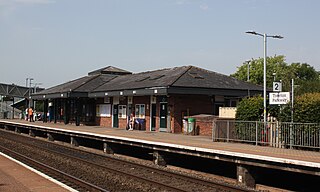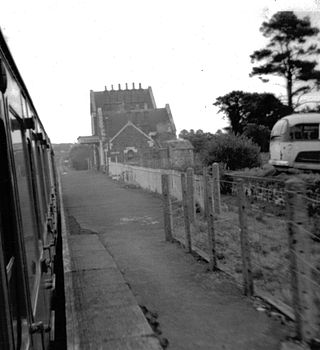
Okehampton is a town and civil parish in West Devon in the English county of Devon. It is situated at the northern edge of Dartmoor, and had a population of 5,922 at the 2011 census. Two electoral wards are based in the town. Their joint population at the same census was 7,500.

Sampford Courtenay is a village and civil parish in West Devon in England, most famous for being the place where the Western Rebellion, otherwise known as the Prayerbook rebellion, first started, and where the rebels made their final stand. It has a population of around 600.

The Dartmoor line is a 15+1⁄2-mile (24.9 km) railway line in Devon, England. From Crediton, the line runs alongside the Tarka Line to the site of the former Coleford Junction where it diverges west to Okehampton. Previously a heritage line, it is owned by Network Rail.

Exeter St Davids railway station is the principal and largest railway station in Exeter, also the second-busiest station in Devon.

Tiverton Parkway railway station is on the Bristol to Exeter line in Devon, England. Despite being named after the town of Tiverton, it is actually located a short distance from the village of Sampford Peverell, 6 miles (9.7 km) to the east of Tiverton, and close to the junction of the M5 motorway with the A361 North Devon link road. It is 177 miles (285 km) from the zero point at London Paddington via Bristol Temple Meads.

Crediton railway station is a railway station serving the town of Crediton in Devon, England. It is 7 miles 76 chains (12.8 km) from Exeter Central at milepost 179.25 from London Waterloo.

Okehampton railway station is a terminus railway station on the Dartmoor line serving the town of Okehampton in Devon, England. The station closed to regular traffic in 1972, but heritage and occasional mainline services ran from 1997 to 2019. Regular railway services resumed in November 2021.

Yeoford railway station is a rural station serving the village of Yeoford in Devon, England. It is on the Tarka Line to Barnstaple, 11 miles 42 chains (18.5 km) from Exeter Central at milepost 183 from London Waterloo.

The South Devon and Tavistock Railway linked Plymouth with Tavistock in Devon; it opened in 1859. It was extended by the Launceston and South Devon Railway to Launceston, in Cornwall in 1865. It was a broad gauge line but from 1876 also carried the standard gauge trains of the London and South Western Railway between Lydford and Plymouth: a third rail was provided, making a mixed gauge. In 1892 the whole line was converted to standard gauge only.

Meldon is a hamlet in West Devon, on the edge of Dartmoor in Devon, England. It is 4 km south-west of Okehampton. Its main features are the Meldon Quarry and Meldon Reservoir and the nearby Meldon Viaduct.
The Okehampton–Bude line was a railway line built to serve Holsworthy in Devon, and Bude on the Cornish coast near the Devon border in England. The line branched from the main line at Meldon Junction to the west of Okehampton on the northern edge of Dartmoor. The line opened in 1879 to Holsworthy and in 1898 to Bude. It is now closed.

The Exeter to Plymouth railway of the London and South Western Railway (LSWR) was the westernmost part of a route competing with that of the Great Western Railway (GWR) and its 'associated companies' from London and Exeter to Plymouth in Devon, England. Whereas the GWR route from Exeter followed the coast to Newton Abbot and then went around the southern edge of Dartmoor, the LSWR route followed the northern and western margins of Dartmoor, passing through the towns of Crediton, Okehampton, and Tavistock.

Sampford Courtenay railway station is a disused railway station at Belstone Corner, which used to serve the nearby village of Sampford Courtenay in Devon. The village lies 3 minutes away by car or around 30 minutes by foot via the B3215. In 2018–19 it was the least used station in Devon and in the South West and the tenth least used station in Great Britain. In 2020-21 it was the joint least used station in Great Britain with zero passengers.

Bow railway station was a railway station serving the village of Bow and the hamlet of Nymet Tracy in Devon. Bow lies about 8 miles west of Crediton.

North Tawton railway station was a railway station serving the town of North Tawton in Devon, England. North Tawton lies on the River Taw.

Meldon Quarry is a granite quarry in Devon, England. It is at the northern edge of Dartmoor, about 2 miles SW of Okehampton. It was developed from 1897 to supply track ballast and other stone products for the London and South Western Railway (LSWR). It was privatised in 1994.

The Granite Way is a route of 18 km consisting mainly of a motor traffic-free cycle/walkway between Okehampton and Lydford. It was built by Devon County Council (DCC) and is part of the National Cycle Network (NCN) Route 27 ‘Devon Coast to Coast’ between Ilfracombe and Plymouth. It is maintained jointly by DCC and Sustrans. Currently, the Way is supported by a Sunday-only train service during summer months to and from Okehampton railway station providing links to nearby Exeter run by DCC and Great Western Railway.

Meldon Viaduct is a disused railway viaduct crossing the West Okement River at Meldon, 2.5 miles (4.0 km) south-west of Okehampton, on the edge of Dartmoor in Devon, South West England. This truss bridge was constructed from wrought iron, instead of stone or brick arches. It opened in 1874 for a single track; in 1879 its width was doubled for a second track. Although regular services were withdrawn in 1968, the bridge was used for shunting by a local quarry. In the 1990s the remaining single track was removed.
Okehampton Interchange is a proposed railway station in Okehampton on the Dartmoor Line. The station would be part of the Devon Metro and has been described as a priority station. The station is to be sited off Exeter Road, by the Business Park and close to the junction with the A30, in the Stockley Hamlet area of Okehampton. It would also serve 900 new homes to be built nearby.

The Devon Metro is the name given to the urban railway network in Exeter and its environs, which since 2011 has been undergoing a metroisation scheme by Devon County Council to provide a rapid transit-style service through incremental upgrades to the existing system. This includes increasing the frequency of trains on existing lines, opening new lines and stations, and improving integration between lines and other modes of transport. Through these upgrades the network is to gradually become a "turn-up-and-go" service without having to refer to a timetable, like more conventional metro systems.



















